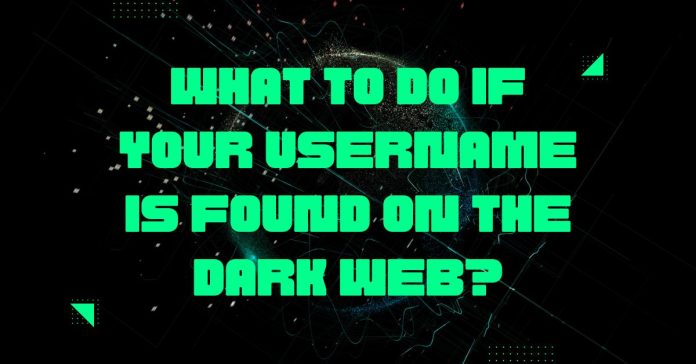Learn what to do if your username is found on the dark web in this post.
In today’s digital age, our online presence extends far beyond the surface web that most of us use daily. Beneath this visible layer lies the dark web, a hidden part of the internet not indexed by standard search engines.
While the dark web has legitimate uses, it’s also notorious for hosting illegal activities and trading stolen personal information. If you’ve discovered that your username has appeared on the dark web, it’s natural to feel alarmed.
This blog post will guide you through understanding the implications of this discovery and provide actionable steps to protect your digital identity.
Table of Contents
Understanding the Dark Web and Its Implications
Before diving into the actions you should take when your username is found on the dark web, it’s crucial to understand what the dark web is and why finding your username there is concerning.
The dark web is a part of the internet that requires special software, like Tor, to access. It offers anonymity to its users, which unfortunately makes it attractive for criminal activities. Common illicit uses of the dark web include:
- Selling stolen personal information
- Trading hacked account credentials
- Sharing illegal content
- Coordinating cybercrime activities
If your username appears on the dark web, it could indicate several things:
- Your account credentials may have been compromised in a data breach
- Your personal information might be for sale
- Your online identity could be at risk of being used for fraudulent activities
It’s important to note that finding your username on the dark web doesn’t automatically mean you’re a victim of identity theft or that your accounts have been hacked. However, it does warrant immediate action to protect yourself.
Immediate Steps to Take
1. Don’t Panic, But Act Quickly
While discovering your username on the dark web is concerning, it’s essential to remain calm and approach the situation methodically. Panic can lead to hasty decisions that might not be in your best interest. Instead, take prompt, well-thought-out actions to secure your online presence.
2. Change Your Passwords Immediately
The first and most crucial step is to change your passwords for all online accounts, especially those associated with the username found on the dark web. When creating new passwords:
- Use a unique, strong password for each account
- Aim for at least 12 characters, including a mix of uppercase and lowercase letters, numbers, and symbols
- Avoid using personal information that could be easily guessed
- Consider using a passphrase instead of a single-word
3. Enable Two-Factor Authentication (2FA)
Two-factor authentication adds an extra layer of security to your accounts. Even if someone has your password, they won’t be able to access your account without the second factor, typically a code sent to your phone or generated by an authenticator app. Enable 2FA on all accounts that offer this feature, especially for:
- Email accounts
- Financial services
- Social media platforms
- Cloud storage services
- Work-related accounts
4. Check for Suspicious Activity
Review your accounts for any signs of unauthorized access or unusual activity. Pay close attention to:
- Email accounts: Check sent items, trash, and account settings for any changes you didn’t make
- Financial accounts: Look for unauthorized transactions or changes to your personal information
- Social media: Check for posts you didn’t make or messages sent without your knowledge
- Online shopping accounts: Verify your order history and saved payment methods
5. Run a Comprehensive Malware Scan
Your device might be infected with malware that’s compromising your online security. Use a reputable antivirus program to perform a full system scan on all your devices. Consider using additional anti-malware tools for a more thorough check.
TOP Identity Protection Services
Before diving into specific actions you can take when your username is found on the dark web, it’s worth considering professional identity protection services. These services can provide ongoing monitoring and assistance in protecting your personal information. Here are a few reputable options to consider:
OmniWatch
This service offers comprehensive identity monitoring, including dark web surveillance. They scan various online sources for personal information and alert you to threats.
Incogni
Specializing in data broker removal, Incogni helps reduce your digital footprint by continuously requesting the removal of your personal information from numerous data brokers and people search sites.
DeleteMe
As the name suggests, DeleteMe focuses on removing your personal information from public databases and websites. They offer both one-time and subscription-based services to keep your data private.
While these services can be valuable tools in protecting your identity, they shouldn’t replace personal vigilance and the steps we’ll discuss next. Consider them as an additional layer of protection in your overall identity security strategy.
15 Long-Term Protection Strategies For Your Digital Security
After taking immediate action, it’s time to focus on long-term strategies to enhance your digital security and prevent future incidents.
1. Use a Password Manager
A password manager helps you create and store strong, unique passwords for all your accounts. This tool eliminates the need to remember multiple complex passwords and reduces the risk of using weak or repeated passwords. Popular options include:
- LastPass
- 1Password
- Dashlane
- Bitwarden
When choosing a password manager, consider security features, ease of use, and cross-platform compatibility.
2. Regularly Monitor Your Credit Reports
Keep a close eye on your credit reports to catch any signs of identity theft early. In the United States, you’re entitled to one free credit report annually from each of the three major credit bureaus: Equifax, Experian, and TransUnion.
Consider spacing these out to check your credit every four months.
Look for:
- Accounts you don’t recognize
- Hard inquiries you didn’t authorize
- Addresses where you’ve never lived
- Employers you’ve never worked for
If you notice any discrepancies, report them to the credit bureau immediately.
3. Set Up Identity Theft Monitoring
Consider subscribing to an identity theft monitoring service. These services keep an eye on your personal information across the internet, including the dark web, and alert you to potential threats.
Some popular options include:
- IdentityForce
- LifeLock
- Identity Guard
- Experian IdentityWorks
While these services can’t prevent all forms of identity theft, they can provide early warnings and assist in recovery if your identity is compromised.
4. Be Cautious with Personal Information Sharing
Limit the amount of personal information you share online. Be particularly careful with:
- Social media posts: Avoid sharing details that could be used to answer security questions
- Online forms: Only provide necessary information and be wary of unsecured websites
- Public Wi-Fi: Use a VPN when connecting to public networks to encrypt your data
5. Educate Yourself on Phishing and Social Engineering
Many data breaches occur due to human error, often through phishing attacks or social engineering.
Learn to recognize these threats:
- Be skeptical of unsolicited emails, especially those asking for personal information
- Verify the sender’s email address and look for signs of spoofing
- Don’t click on links or download attachments from unknown sources
- Be wary of phone calls or messages claiming to be from official organizations and requesting personal information
6. Keep Software and Systems Updated
Regularly update your operating system, browsers, and applications. These updates often include security patches that address newly discovered vulnerabilities. Enable automatic updates to ensure you’re always protected against the latest threats.
7. Use Secure and Private Browsing Practices
Enhance your online privacy and security by:
- Using a VPN to encrypt your Internet traffic
- Opting for privacy-focused browsers like Brave or Firefox
- Using privacy-enhancing browser extensions (e.g., uBlock Origin, Privacy Badger)
- Regularly clearing your browser history and cookies
8. Implement Email Security Measures
Your email account is often the gateway to many of your online accounts. Strengthen its security by:
- Using a strong, unique password
- Enabling two-factor authentication
- Being cautious about clicking links or downloading attachments
- Using email encryption for sensitive communications
9. Regularly Review Connected Apps and Services
Periodically review the apps and services connected to your main accounts (e.g., Google, Facebook, Twitter). Revoke access for any apps you no longer use or don’t recognize.
10. Consider Freezing Your Credit
If you’re particularly concerned about identity theft, consider placing a security freeze on your credit reports. This makes it more difficult for criminals to open new accounts in your name. Remember that you’ll need to lift the freeze when applying for credit temporarily.
11. Stay Informed About Data Breaches
Keep yourself updated on recent data breaches, especially those affecting your services. Websites like Have I Been Pwned can alert you if your email address appears in known data breaches.
12. Be Cautious with IoT Devices
If you use Internet of Things (IoT) devices, ensure they’re secure:
- Change default passwords
- Keep firmware updated
- Disable unnecessary features
- Use a separate network for IoT devices if possible
13. Implement Network Security at Home
Secure your home network to protect all connected devices:
- Use a strong, unique password for your Wi-Fi
- Enable WPA3 encryption if available
- Keep your router’s firmware updated
- Consider setting up a guest network for visitors
14. Be Mindful of Physical Security
Digital security isn’t just about online practices. Protect your devices physically:
- Use screen locks and strong passwords on all devices
- Enable remote tracking and wiping features
- Be cautious when using devices in public places
- Properly dispose of old devices by securely erasing all data
15. Educate Family Members
If you share devices or accounts with family members, ensure they also practice good digital hygiene. Educate them about the importance of strong passwords, recognizing phishing attempts, and being cautious with personal information online.
What to Do If You Suspect Identity Theft?
If you find concrete evidence that your identity has been stolen, take these additional steps:
- File an identity theft report with the Federal Trade Commission (FTC) at IdentityTheft.gov
- Contact your local law enforcement agency to file a police report
- Place a fraud alert on your credit reports
- Contact companies where you know fraud occurred
- Consider hiring an identity theft recovery service
Conclusion
Now, you should know what to do if your username is found on the dark web. Discovering your username on the dark web can be unsettling, but it’s not the end of the world.
By taking prompt action and implementing robust security practices, you can significantly reduce the risk of becoming a cybercrime or identity theft victim.
Remember, online security is an ongoing process. Regularly review and update your security measures, stay informed about new threats, and protect your digital identity proactively. While it may seem daunting, the time and effort invested in securing your online presence is well worth the peace of mind it brings.
Following the steps outlined in this guide, you’ll address the immediate concern of your username appearing on the dark web and establish a strong foundation for long-term digital security. Stay vigilant, stay informed, and take control of your online safety.
INTERESTING POSTS
About the Author:
Meet Angela Daniel, an esteemed cybersecurity expert and the Associate Editor at SecureBlitz. With a profound understanding of the digital security landscape, Angela is dedicated to sharing her wealth of knowledge with readers. Her insightful articles delve into the intricacies of cybersecurity, offering a beacon of understanding in the ever-evolving realm of online safety.
Angela's expertise is grounded in a passion for staying at the forefront of emerging threats and protective measures. Her commitment to empowering individuals and organizations with the tools and insights to safeguard their digital presence is unwavering.









